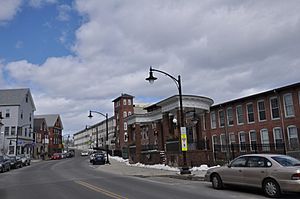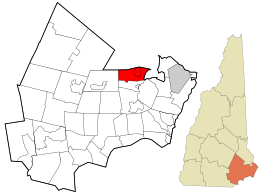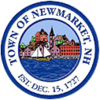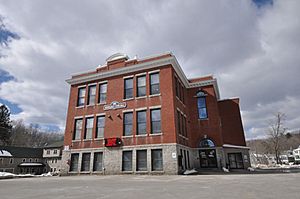Newmarket, New Hampshire facts for kids
Quick facts for kids
Newmarket, New Hampshire
|
||
|---|---|---|

Downtown Newmarket
|
||
|
||

Location in Rockingham County and the state of New Hampshire
|
||
| Country | United States | |
| State | New Hampshire | |
| County | Rockingham | |
| Incorporated | 1727 | |
| Area | ||
| • Total | 14.2 sq mi (36.7 km2) | |
| • Land | 12.6 sq mi (32.6 km2) | |
| • Water | 1.6 sq mi (4.1 km2) 11.24% | |
| Elevation | 39 ft (12 m) | |
| Population
(2020)
|
||
| • Total | 9,430 | |
| • Density | 749/sq mi (289.1/km2) | |
| Time zone | UTC-5 (Eastern) | |
| • Summer (DST) | UTC-4 (Eastern) | |
| ZIP code |
03857
|
|
| Area code(s) | 603 | |
| FIPS code | 33-52340 | |
| GNIS feature ID | 0873683 | |
Newmarket is a town in Rockingham County, New Hampshire, United States. It's a place where many people live, work, and study. In 2020, about 9,430 people lived here.
Some residents of Newmarket are students or staff at the nearby University of New Hampshire. This university is located in Durham. The busiest part of town, where most people live, is right where two main roads, New Hampshire Route 108 and 152, meet. This area is also along the Lamprey River.
Contents
History of Newmarket
Early Beginnings
Newmarket became an official town in 1727. It was one of six towns given land by Massachusetts during the time of King George I. Before becoming a full town, it was a smaller part of Exeter.
The government officially made Newmarket a town in 1737. It was likely named after a town called Newmarket in Suffolk, England. A river flowing through the town, the Lamprey River, got its name from an early settler named John Lamprey. For a short time, the town was even called "Lampreyville."
Shipping and Shipbuilding
Newmarket was an important center for trade in New England. Ships from Newmarket would travel to the West Indies. The town sent out timber, dried fish from the Squamscott River, and salted fish called alewives from the Lamprey River.
When the ships returned, they brought back items like whale oil, molasses, and rum. Newmarket was also very active in shipbuilding. Many ships for the Royal Navy were built here using trees from Newmarket and nearby towns. Records show that Newmarket built 21 ships in just one year!
The Mill Era
In 1822, the Newmarket Manufacturing Company was started. This company built its first cotton textile mill between 1823 and 1824. The company became very important to the town's economy. It had seven textile mills that used the power of the river's waterfalls.
The company brought cotton from the southern United States. This meant that the Civil War caused problems for their production. The company also built many homes for its workers. To make sure they had enough water, they built dams far upriver. These dams created Pawtuckaway Pond and Mendums Pond. During dry times, the company could release water from these dams to keep the mills running. The company eventually closed in 1929.
In the 1970s, the mill buildings became the main office for the Timberland Company. Timberland started as a small company making work boots. It grew into a big fashion brand. Today, Timberland's main office is in nearby Stratham. The old mill buildings are now used for shops and homes. They are part of a special historic area listed on the National Register of Historic Places.
Town Changes
In 1895, a part of Newmarket called "South Newmarket" became its own separate town. This new town is now known as Newfields.
Geography of Newmarket
Newmarket is located in southeastern New Hampshire, right next to Great Bay. The town has two main rivers: the Lamprey River and its smaller branch, the Piscassic River.
The highest point in Newmarket is Bald Hill, which is about 281 feet (86 meters) above sea level. Another important hill, Great Hill, is 228 feet (69 meters) high and is just south of the town center.
The town covers a total area of about 36.7 square kilometers (14.2 square miles). Most of this is land (32.6 sq km or 12.6 sq mi), and about 4.1 sq km (1.6 sq mi) is water. This means about 11.24% of the town is water.
Newmarket is connected by New Hampshire Route 108 and is the end point for New Hampshire Route 152.
Nearby Towns
Newmarket shares its borders with several other towns:
- Durham (to the north)
- Newington (to the northeast)
- Greenland (to the east)
- Stratham (to the southeast)
- Newfields (to the south)
- Epping (to the west)
- Lee (to the northwest)
People of Newmarket
| Historical population | |||
|---|---|---|---|
| Census | Pop. | %± | |
| 1790 | 1,137 | — | |
| 1800 | 1,027 | −9.7% | |
| 1810 | 1,061 | 3.3% | |
| 1820 | 1,083 | 2.1% | |
| 1830 | 2,013 | 85.9% | |
| 1840 | 2,746 | 36.4% | |
| 1850 | 1,937 | −29.5% | |
| 1860 | 2,034 | 5.0% | |
| 1870 | 1,987 | −2.3% | |
| 1880 | 2,368 | 19.2% | |
| 1890 | 2,742 | 15.8% | |
| 1900 | 2,892 | 5.5% | |
| 1910 | 3,348 | 15.8% | |
| 1920 | 3,181 | −5.0% | |
| 1930 | 2,511 | −21.1% | |
| 1940 | 2,640 | 5.1% | |
| 1950 | 2,709 | 2.6% | |
| 1960 | 3,153 | 16.4% | |
| 1970 | 3,361 | 6.6% | |
| 1980 | 4,290 | 27.6% | |
| 1990 | 7,157 | 66.8% | |
| 2000 | 8,027 | 12.2% | |
| 2010 | 8,936 | 11.3% | |
| 2020 | 9,430 | 5.5% | |
| U.S. Decennial Census | |||
In 2010, there were 8,936 people living in Newmarket. There were 3,857 households, which are groups of people living together. The town's population has grown steadily over the years.
Most people in Newmarket are white (92.2%). There is also a growing population of people from Laos and Laotian American families. Some of these families practice Buddhism and attend a temple in Lowell, Massachusetts.
Fun Things to See and Do
Places to Visit
- Stone School Museum: Learn about the history of education in Newmarket.
- The Stone Church: A popular place to see live music.
- New Hampshire Historical Marker No. 209: This marker tells about Wentworth Cheswill (1746–1817), an important historical figure.
- New Hampshire Historical Marker No. 290: This marker honors Henry "Hammerin' Hank" Wajda (1934–1973), a famous jockey.
Town Services
Newmarket has its own Fire and Rescue department. This team includes both full-time staff and volunteers. They help with fires and provide emergency medical services. They also help the nearby town of Newfields with ambulance services. The department has about 45 volunteers and two full-time staff members.
In 2017, some staff members received an award for their brave actions at a car accident. Newmarket also has several places where you can charge electric vehicles, like at the Newmarket Library and Schanda Park.
Famous People from Newmarket
Born in Newmarket
- Charles Branscomb (1822–1891): A lawyer who helped start Lawrence, Kansas.
- Wentworth Cheswell (1746–1817): A justice of the peace and important figure in early American history.
- Tom Gunning (1862–1931): A professional baseball catcher in the 1880s.
- Henry Wajda (1934–1973): A famous jockey in horse racing.
People Who Lived in Newmarket
- Liza Corso (born 2003): An American Paralympic runner.
- Lynn Jennings (born 1960): An Olympic bronze medalist in running.
- Bill Morrissey (1951–2011): A well-known folk singer-songwriter.
- Chad Young (1995–2017): A professional bicycle racer.
Images for kids
See also
 In Spanish: Newmarket (Nuevo Hampshire) para niños
In Spanish: Newmarket (Nuevo Hampshire) para niños







